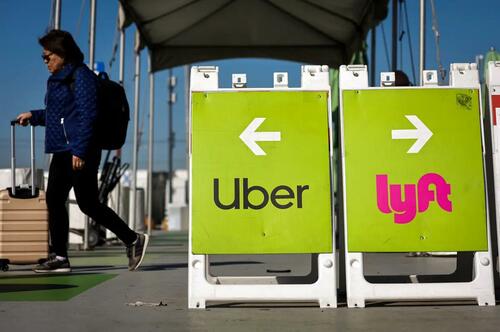Why App-Based Jobs Don’t Pay Like They Used To
Authored by Austin Alonzo via The Epoch Times (emphasis ours),
More Americans than ever are turning to the so-called gig economy—providing services ranging from taxi services to grocery deliveries, often through digital platforms—either on the side or as a career.
The marketplace, however, is no longer the “subsidized fantasy land” it once was, one former gig worker says. An analyst described pursuing gig work as a career as “the biggest mistake of your life.”
Several app-based drivers say the pay now is barely worth the effort. Others say there are issues such as lack of transparency around net pay.
Sergio Avedian, 57, a part-time driver in the Los Angeles area, told The Epoch Times workers are told they are making a certain hourly wage, but the amount is often misleading.
In reality, workers are paid only for time spent with a passenger or package in the car. So if gig workers spend an average of 15 minutes fulfilling a task and the rest of the hour either looking for or driving to a job, they are paid only for a quarter of the time they actually work.
Eddie Doyle, 36, a writer and content creator in the Philadelphia area who is mostly retired from driving for Uber and Lyft, said that on balance, most workers whose gig involves driving are probably actually losing money due to fuel expenses and the deterioration of their vehicles.
Doyle, who began driving in 2015, said pay used to be better. These days, Doyle said Uber or Lyft drivers in a major American city likely need to work 60 to 80 hours a week—splitting driving time among multiple apps—to earn a decent wage.
“I think the vast majority of [gig workers] are struggling,” Pedro Santiago, 42, a driver based near St. Louis who splits his working time among five app-based gig jobs, told The Epoch Times.
Sizing Up the Gig Economy
The world of employment was revolutionized with the launch of Uber Technologies Inc. in 2010. The smartphone application offered a new competitor to the taxicab industry by linking a paying passenger with a private driver using his or her own car.
Uber’s meteoric rise bred dozens of other applications, bringing the gig work concept to other business areas. Today’s smartphone-powered gig economy includes everything from odd jobs around the house to legal work.
The largest services are still focused on transportation. Uber and Lyft Inc. dominate the on-demand ride business, while DoorDash Inc. and Maplebear Inc., better known as Instacart, lead the way on delivery services for food and other goods. Uber has branched out into food and grocery delivery too. DoorDash, Instacart, Lyft, and Uber are now publicly traded.
Massive retailers like Walmart and Amazon joined in with their own on-demand platforms: Spark Driver and Amazon Flex.
Gig workers are recruited with the promise of flexible hours to earn additional income. However, as independent contractors, gig workers are not entitled to traditional employment benefits like health insurance, and they must take on additional occupational risks, equipment costs, and tax burdens.
The U.S. Department of Labor doesn’t measure the number of people working gig jobs. But its Bureau of Labor Statistics does keep track of the number of people working multiple jobs.
According to the BLS’s September Employment Situation Summary, about 8.3 million Americans worked multiple jobs in August 2024. That was an increase from about 7.8 million in August 2023. In both years, most workers with two jobs had a full-time job and a part-time job.
In a 2024 economic impact report, Flex, a federal lobbying association supported by DoorDash, Grubhub, HopSkipDrive, Instacart, Lyft, Shipt, and Uber, estimated there were about 7.3 million “active drivers and delivery partners on major rideshare and delivery platforms” in 2022.
Representatives of Flex did not respond to a request for comment from The Epoch Times.
Other estimates said the number of gig workers is much higher.
A 2022 report published by the consultancy McKinsey & Co. surveyed workers and estimated as many as 58 million Americans, or 36 percent of the U.S. workforce, did some gig work that year.
According to the McKinsey survey, gig workers are most likely Latinos between 18 and 24 with less than a high school education, making less than $25,000 per year.
Santiago said the sheer number of people doing gig work demonstrates the struggles of most Americans.
“Most people come to [gig work] because they either lost a job, or the inflation of their rent and groceries has just gotten too out of hand where they’ve got to make an extra $200 a week,” Santiago said.
Struggling to Make a Living
Some gig workers say they are being left behind. They complain of low pay, unreliable job offerings, and a lack of benefits.
In an email, Rafael Espinal, executive director and president of the Freelancers Union, said many freelancers and gig workers in the United States say their lack of job stability and benefits “prevents them from reaching key life milestones.”
“Inconsistent income and the high cost of health care and housing make it difficult for them to save for retirement, buy a home, or start a family,” Espinal said. “This economic uncertainty affects not only their day-to-day lives but their long-term goals as well.”
Espinal said the Freelancers Union represents more than 700,000 members across the country. It provides access to insurance, legal services, and financial planning for its members. He said many of its members work multiple part-time jobs “to make ends meet.”
Avedian, a Wall Street veteran and a senior contributor to the industry analysis and advice website The Rideshare Guy, said gig work is designed as a so-called side hustle and cannot replace a full-time job for most people.
“If you’ve chosen gig work as a career, you have made the biggest mistake of your life,” Avedian told The Epoch Times.
Both Doyle and Avedian said they believe the active-hour pay structure is misleading to gig workers. Doyle said gig work companies succeed by taking advantage of workers’ ignorance of the risks and costs inherent in gig work.
Espinal said gig workers tell him they are frustrated with their lack of bargaining power as independent contractors even though gig economy companies hold “significant control over their working conditions.”
In its Securities and Exchange Commission filings, Uber describes the classification of its drivers as “employees, workers, or quasi-employees” as an “operational risk” to its business. The same document details the various legal and political challenges involved in maintaining independent contractor status.
Uber’s latest quarterly filing, published in August, said that if drivers win the reclassification through legal means or the passage of new laws, the company would incur significant expenses for compensating drivers and would pass its elevated costs onto riders. Uber also argues reclassification would limit its ability to find workers due to a loss of flexibility.
The second-quarter reports filed by DoorDash, Instacart, and Lyft make nearly identical statements about classification and describe similar legal and political challenges to gig workers’ contractor status.
Profitability and the Future
The gig economy shows no signs of slowing down. Americans are used to the on-demand goods and services provided by gig workers, and corporations are eager to cut labor costs by expanding their use of independent contractors.
The latest earnings statements show Uber, Lyft, and Instacart all turned a profit in the second quarter of 2024.
According to their SEC filings, Uber collected $361 million in profits during the first six months of 2024, while DoorDash reported $191 million in profits. During the same period, Lyft lost about $26.5 million, while DoorDash lost $180 million.
Read the rest here…
Tyler Durden
Mon, 09/23/2024 – 05:00
via ZeroHedge News https://ift.tt/CmFdYQZ Tyler Durden


